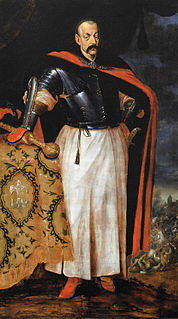 W
WHrehory Chodkiewicz was a Ruthenian noble and military officer of the Grand Duchy of Lithuania. He was a son of Aleksander, brother of Hieronim and Yurii, and uncle of Jan Hieronimowicz Chodkiewicz. He commanded the Lithuanian army during the later part of the Livonian War after he had become the Great Lithuanian Hetman in 1566.
 W
WJan Karol Chodkiewicz was a military commander of the Polish–Lithuanian Commonwealth army who was from 1601 Field Hetman of Lithuania, and from 1605 Grand Hetman of Lithuania, and was one of the most prominent noblemen and military commanders of the Polish–Lithuanian Commonwealth of his era. His coat of arms was Chodkiewicz, as was his family name.
 W
WStanisław Michał Ernest Denhoff was a Polish–Lithuanian Commonwealth aristocrat, Grand Master of the Hunt of Lithuania, Grand Chorąży of the Crown (1704–1721), voivode of Połock (1721–1728), politician and a military commander.
 W
WWincenty Aleksander Korwin Gosiewski de armis Ślepowron – was a Polish nobleman, general, Field-Commander of Lithuania from 1654, Grand Treasurer of Lithuania and Lithuanian Great-Quartermaster since 1652, General of Artillery of Lithuania from 1651, Grand-Master of the Pantry of Lithuania from 1646.
 W
WJanusz Kiszka was a Polish politician and magnate in the 17th century Polish–Lithuanian Commonwealth. Last of the Kiszka family. Royal Rotmistrz, starosta of Parnawa from 1610, Voivode of Polock since 1621, Field Lithuanian Hetman since 1635, Great Lithuanian Hetman since 1646.
 W
WSzymon Marcin Kossakowski was a Polish–Lithuanian nobleman (szlachcic), and one of the leaders of the Targowica Confederation. In 1793, he became the last Great Hetman of Lithuania.
 W
WPrince Michał Józef Masalski was a Polish-Lithuanian nobleman (szlachcic).
 W
WGrzegorz Antoni Ogiński was a Polish-Lithuanian Hetman and governor-general of the Duchy of Samogitia from 1698. He was the fourth and youngest son of Jan Jacek Ogiński, also a hetman.
 W
WMichał Kazimierz Pac of the Gozdawa Coat of Arms, was a Polish-Lithuanian nobleman and a member of the Pac family. He was a son of Piotr Pac ; and a cousin of Krzysztof Zygmunt Pac, the Chancellor of Lithuania.
 W
WLudwik Konstanty Pociej (1664-1730) was a Polish nobleman, podkomorzy of Brest, podskarbi, castelan and voivode of Vilnius, Great and Field Hetman of Lithuania.
 W
WPrince Janusz Radziwiłł, also known as Janusz the Second or Janusz the Younger was a noble and magnate in the Polish–Lithuanian Commonwealth. Throughout his life he occupied a number of posts in the state administration, including that of Court Chamberlain of Lithuania, Field Hetman of Lithuania and Grand Hetman of Lithuania. He was also a voivode of Vilna Voivodeship, as well as a starost of Samogitia, Kamieniec, Kazimierz and Sejwy. He was a protector of the Protestant religion in Lithuania and sponsor of many Protestant schools and churches.
 W
WJerzy Radziwiłł, nicknamed "Herkules", was a Polish–Lithuanian nobleman.
 W
WPrince Krzysztof Radziwiłł was a Polish–Lithuanian noble (szlachcic), and a notable magnate, politician and military commander of his epoch. Sometimes referred to as Krzysztof Radziwiłł II, to distinguish him from his father, Krzysztof Mikołaj 'Piorun' Radziwłł.
 W
WPrince Krzysztof Mikołaj Radziwiłł, nicknamed "Piorun" was a Reichsfürst of the Holy Roman Empire and a member of the nobility of the Polish–Lithuanian Commonwealth.
 W
WPrince Michał Kazimierz Radziwiłł was a Polish–Lithuanian noble and magnate. He is sometimes referred to as the first Michał Kazimierz Radziwiłł, to distinguish him from the other member of his family to use the name.
 W
WPrince Michał Kazimierz Radziwiłł was a Polish–Lithuanian noble. A member of the aristocratic Radziwiłł family, he was frequently referred to by his idiolect Rybeńko (Рыбанька), to distinguish him from the other Michał Kazimierz Radziwiłł. Ordynat of Niasviž and Olyka, owner of Biržai, Dubingiai, Slutsk, Kopyła and Shumsk.
 W
WPrince Roman Fedorovich Sanguszko was a soldier and statesman of the Grand Duchy of Lithuania. He served as governor (voivode) of Bracław and was hetman of Lithuania from 1567 until his death. He fought at the Battle of Ula in 1564 and belonged to the nesuhoizhskoy branch of the House of Sanguszko.
 W
WAleksander Michał Paweł Sapieha of Lis coat of arms was a noble of the Polish–Lithuanian Commonwealth.
 W
WJan Kazimierz Sapieha the Younger (1637–1720) was a Grand Hetman of Lithuania commencing in 1682. He held the title of a Duke starting in 1700. In 1681 he became Field Hetman of Lithuania, the following year he also became the voivode of Vilnius.
 W
WJózef Bogusław Słuszka was a nobleman, statesman and commander of the Grand Duchy of Lithuania. He served as its hetman from 25 April 1685 to 1701 and also became castellan of Vilnius.
 W
WJózef Sylwester Sosnowski, of the Nałęcz coat-of-arms, was a Polish-Lithuanian magnate — Voivode of Smolensk and Połock, Grand Notary of Lithuania (1754), Field Notary of Lithuania (1764–71), Field Hetman of Lithuania (1775–80), a delegate to the Convocation Sejm of 1764, and Marshall of the Electoral Sejm of 1764.
 W
WLudwik Skumin Tyszkiewicz was a Polish–Lithuanian nobleman (szlachcic) and Field Lithuanian Hetman from 1780 to 1791, Great Lithuanian Treasurer from 1791, Great Lithuanian Marshal from 1793. Member of the Targowica Confederation.
 W
WPrince Michał Serwacy Wiśniowiecki (1680–1744) was a Polish-Lithuanian nobleman, magnate, politician, diplomat, general, a successful military commander and the last male representative of the Wiśniowiecki family.
 W
WWładysław Wołłowicz was a nobleman, commander and statesman of the Grand Duchy of Lithuania.
 W
WJózef Zabiełło h. Topór of was a nobleman (szlachcic) in the Polish–Lithuanian Commonwealth. Great Łowczy of Lithuanian from 1775, konsyliarz of Permanent Council from 1782, deputy of Samogitia to the Great Sejm and Field Hetman of Lithuania from 1793, he was infamous for his support of the Russian Empire in the last years of the Commonwealth.